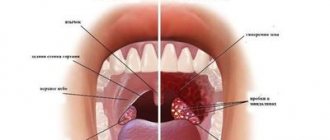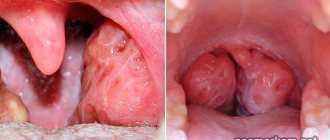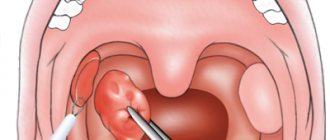Structure of the tonsils
The palatine tonsils, or tonsils, are an important organ of the human immune system. The tonsils are located in the oral cavity on both sides of the pharynx. The tonsils are shaped like an almond (hence the name “almond”) and range in size from one to four centimeters in diameter. The tonsils are endowed with a protective function. They are a kind of barrier to bacteria entering the body through airborne droplets, as well as through food intake. The structural features of the tonsils and the functions they perform are directly related to the appearance of tonsillitis plugs in the throat.
Make an appointment right now!
Call us by phone or use the feedback form
Sign up
On the surface of the tonsils, winding canals and openings are visible - lacunae and crypts.
When viruses from the outside enter the mouth, leukocytes in the tonsils are activated and begin an intensified process of forming antibodies that fight the “enemy.” At the same time, a signal is sent to all organs of the immune system, and the body comes into “combat readiness”.
What are tonsils?
Tonsils are lymph nodes located superficially in the oropharynx between the palatine arches. They represent an organ of immune defense against the threat of pathogenic microorganisms entering the lower respiratory tract, that is, an organ designed to purify the inhaled air from infection, or to localize this infection (take the fire upon itself) in order to prevent its spread below.
Healthy tonsils are formations permeated with “lacunae” and “crypts” (folds and passages), this is designed to greatly increase the surface of the working epithelium, which produces protective antibodies and immunoglobulins. That is, the intentions to have such a “multi-pass” structure are absolutely good. But, as you know, all our advantages are also our shortcomings. So in this case, if healthy tissue of the tonsil should self-clean, and lacunae (pockets) and crypts (passages) should not accumulate any contents, then the tonsil, exhausted from work, cannot cope with this function and accumulates desquamated epithelium in its “feeds”, and sometimes food remains in the form of whitish-yellowish masses, which are an excellent environment for the development of bacteria, as evidenced by the unpleasant odor from these accumulations.
Patients themselves notice that some content accumulates in the tonsils, either by determining this visually, or by the feeling of a foreign body on the right or left, “tingling” when swallowing, sometimes this discharge can be coughed up and spat out, or is discovered as an accidental finding when examining the throat by an otolaryngologist .
In this case, the tonsil no longer works as a protective organ and is rather a source of infection.
What is tonsillitis?
Tonsillitis is an inflammatory process in the tonsils. The disease can be acute or chronic. The acute form is better known as tonsillitis. In chronic cases, periods of exacerbation (inflammation of the tonsils) are replaced by a period of remission (calm). Most often, the disease occurs in children 5-15 years old, although adults are also susceptible to the disease. The tonsils in children are larger than in adults. The palatine tonsils reach their maximum size by the age of 7, and then begin to shrink. Constant viral attacks on the tonsils lead to tonsillitis. Chronic tonsillitis most often acts as a complication after an infectious disease (sore throat, caries, etc.). The chronic form of the disease, according to statistics, occurs in 5% of adults and 11% of children. That is, chronic tonsillitis is a common disease. Tonsillitis plugs on the tonsils often appear with chronic tonsillitis.
Causes of chronic tonsillitis
The chronic form of tonsillitis often develops as a complication after a sore throat. Many patients try to cure a sore throat on their own and take medications uncontrollably. Some, having received doctor’s recommendations, do not follow the instructions and finish the course of taking antibacterial drugs earlier than expected, noticing an improvement. This is a huge mistake! Untreated sore throat causes the disease to enter the chronic stage and the formation of tonsillitis with purulent plugs. The main causative agents of the disease are streptococci and staphylococci.
Exacerbation of tonsillitis is favored by:
- chronic inflammatory process (sinusitis, caries, sinusitis, etc.);
- proliferation of adenoids;
- deviated nasal septum;
- damage to the tonsils;
- hypothermia;
- weak immunity.
Why do traffic jams occur with tonsillitis?
The main factor in the formation of purulent plugs on the tonsils is the constant presence of a focus of inflammation, provoked by viruses. There are always bacteria in the human mouth - they are not dangerous to health. Once in the gaps, they are killed by immune cells. The tonsils of a healthy person are capable of self-cleaning - dead microorganisms are removed from the lacunae and enter the stomach with saliva, where they are destroyed under the influence of gastric juice.
But as soon as dangerous viruses enter the body, a large number of leukocytes are sent to fight them, the mucous membrane of the tonsils swells, and self-cleaning of the lacunae under such conditions becomes difficult. Dead bacteria and leukocytes begin to accumulate in the tonsils - purulent-caseous formations appear. If you do not consult an otolaryngologist in time and do not begin treatment for purulent tonsillitis plugs, the process can become irreversible and lead to the destruction of the tonsils.
Purulent formations and chronic tonsillitis
In the chronic form of the disease, inflammation in the tonsils does not completely disappear, but only subsides for a while. Bacteria are always present in the lacunae of the tonsils, and the increased formation of a large number of leukocytes does not stop. Since the chronic form is characterized by the absence of pronounced signs of the disease, the appearance of purulent plugs goes unnoticed by the patient. White blood cells surround the bacteria, and a purulent formation appears. Over time, substances containing calcium and magnesium accumulate in them. As a result, the plugs harden.
Among the reasons for the formation of traffic jams are:
- diseases of the nasal cavity that are chronic (for example, sinusitis) - some of the bacteria from the nose certainly gets into the throat;
- lack of proper oral hygiene - here bacteria are constantly present and when immunity decreases, they enter the tonsils; food debris can also get stuck in the gaps and become “material” for the hardening of purulent masses;
- weak immunity - a person is unable to cope with the infection on his own, and the disease becomes protracted or chronic;
- damage to the tonsils - infection can easily get into the wound. Often it is the site of injury that becomes the location of a new purulent formation.
What to do in case of tonsil blockages?
Of course, see an otolaryngologist in a specialized ENT office; in Moscow, this can be done at ENT Clinic No. 1 , where you will receive treatment, including sanitation of the tonsils ( washing the tonsil plugs ). Of great importance in treatment is the availability of this organ for washing with medicines, both manually (special instruments) and physiotherapy.
The tonsil tissue is very well healed when treated with the “Tonsillor” apparatus, when ultrasonic washing of the tonsils occurs, followed by phonophoresis of a medicinal substance into the tonsil tissue. When treated with tonsillitis, the tonsils are both cleansed and significantly reduced in diameter, inflammation is relieved, and pathogenic microflora is destroyed. In addition to this technique, the non-contact method of treating tonsils is widely used: USOL therapy, endolacunar laser therapy, and photochromotherapy.
ENT specialists - doctors of ENT clinic number 1 will individually select a treatment method and take you for follow-up at the dispensary. The course of treatment is usually 8-10 procedures. Since the process of inflammation in the tonsils in this case is chronic, it is advisable to repeat the course of treatment every six months, which will help you maintain the protective function of the tonsils, significantly improve the quality of life (reduce morbidity), and prevent the development of serious complications.
It should be noted that with regular treatment for 2-3 years, some patients may experience complete recovery and restoration of tonsil function, which does not require further courses of anti-relapse therapy.
Symptoms of purulent plugs in the throat
Traffic jams are a factor by which chronic tonsillitis can be recognized. Therefore, when traffic jams appear, all the signs of this chronic disease are present. The following symptoms can be identified during an exacerbation of tonsillitis.
Constantly recurring sore throats - if there is inflammation in the tonsils, then this is not an indicator of chronic tonsillitis. But if a person is susceptible to the disease more than two or three times a year, then we can confidently say that we are dealing with a chronic form of the disease.
Friends! Timely and correct treatment will ensure you a speedy recovery!
The next symptom is redness and swelling of the palatine arches, to which inflammation from the tonsils can spread. Adhesions can form between the palatine arches and the tonsils - they seem to stick together with each other.
Enlarged lymph nodes are another sign of the disease. The manifestation of tonsillitis is accompanied by elevated body temperature. In the chronic form, a temperature of 37°C can last from several days to several weeks. The patient feels constant fatigue, lethargy, and performance decreases. All these are signals of adverse changes occurring in the body.
Symptoms of purulent plugs in the throat
The first sign is a feeling that there is something in the throat: like a lump; A dry cough may accompany these unpleasant sensations. The patient has difficulty swallowing and has a sore throat.
Severe pain in the throat is accompanied by a putrid odor from the mouth, which cannot be muffled even with the help of toothpastes. This smell is the result of the activity of bacteria accumulated in traffic jams. Caseous formations are also visible upon visual inspection - curdled tubercles of a white-yellow hue are immediately noticeable on the tonsils. It happens that the pustules are not immediately visible, but as soon as you press on the surface of the tonsil, for example, with your tongue, these white-yellow tubercles begin to appear.
Blockages in the tonsils can bring a lot of unpleasant and even dangerous consequences to the patient: if the infection travels with the blood or lymph flow further through the body, it can cause problems with the heart, kidneys and joints. In order not to have to treat complications from tonsillitis, it is necessary to get an appointment with an otolaryngologist in a timely manner and begin treatment for tonsillitis with purulent plugs.
Symptoms
Small accumulations, as a rule, do not cause significant symptoms. With large accumulations, the patient may experience the following symptoms of inflammation:
- bad breath;
- whitish dots are clearly visible on the surface of the tonsils;
- persistent sore throat;
- pain while swallowing;
- body temperature may be increased to 37-37.7 degrees;
- a feeling of discomfort at the site of accumulation of purulent masses;
- swollen tonsils;
- weakness, lethargy, general malaise;
- decreased performance;
- loss of appetite;
- enlarged lymph nodes;
- pain may radiate to the ears.
Traffic jams appear gradually, so in the early stages of the disease the patient experiences only discomfort when swallowing and a sore throat.
This condition is extremely dangerous for pregnant women! In addition to the fact that it has a detrimental effect on the general condition of the expectant mother, it can negatively affect the development of the fetus and, in the worst case, provoke a miscarriage. Therefore, it is extremely important to contact an otolaryngologist in time to receive competent recommendations on how to effectively treat tonsillitis during pregnancy and avoid complications.
Treatment of tonsillitis plugs
The appearance of plugs indicates long-term inflammation occurring in the body, so the removal of purulent plugs must be combined with measures to treat chronic tonsillitis. Chronic tonsillitis should be treated by a competent otolaryngologist. Only an ENT doctor knows how to treat tonsillitis plugs effectively and safely. There is no need to try to get rid of pustules on your own at home. Many patients begin to put pressure on the tonsils, scraping off the “plaque” with a spoon and other improvised means. But this measure is ineffective - pus is removed only from the surface, but this is only the tip of the iceberg, the main problem is inside. Such inept actions often lead to injury to the tonsils, which will only provoke the appearance of new caseous formations.
Is it possible to cure traffic jams at home?
People suffering from chronic tonsillitis ask the question: “How to remove purulent plugs in the throat?” The vast majority do not seek to contact an otolaryngologist, trying to remove plugs from the throat on their own.
The first method that patients practice at home is squeezing out the plugs with their tongue. By pressing on the tonsil with your tongue, you can remove a small plug in your mouth. This method cannot be called traumatic, but it is also effective. Large purulent accumulations, as well as plugs deep in the lacunae, cannot be reached this way.
The second method is squeezing out caseous masses with a spoon. The algorithm of actions is the same - press on the tonsil so that the purulent “lumps” come out. But the tissues of the inflamed tonsils are very thin, and without taking into account the force of pressure, they can be injured. As a result, the tonsils will begin to bleed. If the procedure is carried out carelessly, without maintaining sterility (and this is difficult to do at home, no matter how hard you try), the wounds can become infected.
Removing caseous mass from the tonsils using these methods is ineffective. Even if the procedure took place without unpleasant consequences, caseous detritus, embedded deep in the thickness of the tonsil, will remain there and will continue to support inflammation. This means the problem will not go away.
Only an ENT doctor can effectively treat purulent plugs.
Conservative method of removing tonsillitis plugs
Conservative treatment consists of:
- Treatment with medications (antibiotics and the duration of treatment is prescribed directly by the ENT doctor. Treatment of chronic tonsillitis should begin at the time of exacerbation, not remission. As a rule, the patient is prescribed the drugs “Amoxicillin”, “Amoxiclav”, “Summamed”, “Azithromycin”, etc. .).
- Gargling (solutions of furatsilin, soda, decoctions of chamomile, St. John's wort, string, from pharmaceutical products - Miramistin, Rotokan, etc. are excellent).
- Inhalations (as agreed with the doctor).
- Rinsing the lacunae of the tonsils (the most effective method for removing purulent accumulations. Performed only by an otolaryngologist. Rinsing is carried out using a syringe or a TONZILLOR device.
When carrying out a course of rinsing, the patient's condition significantly improves, the tonsils look healthier, and are cleared of purulent accumulations.
With chronic tonsillitis, the period of remission of the disease increases.
Treatment of palatal cysts
Tonsil removal
- Cost: 75,000 - 105,000 rubles.
- Duration: 30-40 minutes
- Hospitalization: 1-2 days in hospital
More details
Treatment of cysts is determined by many factors, primarily the size of the cyst, its location, growth rate and the age of the patient. At first, they always try to carry out a high-quality course of conservative treatment, especially anti-inflammatory treatment. Treatment is carried out both general and local.
The radical and best way to treat cysts is surgery, which can be performed in different ways. Small cysts located superficially are removed along with the capsule. After this, a slight scar remains on the tonsil, which soon resolves.
The operation is performed under local anesthesia, the patient does not feel anything. In most cases, the intervention is performed on an outpatient basis, and the person goes home the same day.
A cyst of significant size, especially one located deeply, is removed along with part of the tonsil. If there are several cysts or the location is such that it is impossible to get to them, the tonsil is removed completely and a tonsillectomy is performed.
Surgery
Tonsillectomy - removal of the tonsils - is the most radical way to get rid of the problem. It is used in the most extreme cases, when conservative methods do not bring the desired relief, and the indications for surgery must be quite serious. Before removing tonsils, you need to carefully weigh everything and first try a full range of conservative treatment measures. By removing the tonsils, you are deprived of a natural natural barrier against viruses and infections. You need to fight to preserve your tonsils to the last!
Tonsils are removed using a scalpel, laser or liquid nitrogen. Your ENT doctor will definitely tell you about all the intricacies and consequences of tonsillectomy.
Diagnosis of a cyst
As a rule, detecting a cyst does not cause any particular difficulties, since the pharynx can be clearly seen even with the help of a backlit frontal mirror. The main thing is to contact an otolaryngologist for examination. ENT doctors use various instruments during examination - spatulas, elevators, and, if necessary, endoscopes.
The cyst is determined in different parts of the tonsils, on the surface or in the depths. It has the appearance of an opaque round formation, similar to a ball, whitish in color, elastic and mobile. There may be no signs of inflammation of surrounding tissues.
You cannot touch or put pressure on the cyst yourself - it can burst, and its contents are unknown. At best, the purulent contents will enter the stomach, and at worst, it will spread to other organs.
The doctor examines cysts larger than 1 cm very carefully, without damaging the surrounding tissues, trying not to touch the capsule.
Diagnosis of a cyst includes puncture (puncture and removal of contents). If necessary, the resulting material is examined in the laboratory to understand the nature of the disease. If a malignant process is suspected or blood is leaking from a cyst, treatment begins immediately, without waiting for the end of the examination.
Depending on age, general condition and concomitant diseases, the doctor may prescribe other clinical tests. The blood coagulation system, the functioning of the heart and lungs are required to be examined.
Traditional medicine and preventive measures
Treatment with folk remedies for removing accumulated pus is not entirely effective - plugs located deep in the tonsil cannot be removed. With their help, you can only soften the surface of the plugs to facilitate their rejection and use herbal decoctions when gargling and disinfecting it.
To reduce the risk of traffic jams, you need to follow some simple tips:
- carefully monitor oral hygiene;
- treat sore throat and inflammation in the nose and mouth in a timely manner: sinusitis, frontal sinusitis, caries, stomatitis;
- avoid hypothermia;
- for chronic tonsillitis, follow the recommendations of your ENT doctor, do not forget about preventive complexes of physiotherapy and tonsil rinsing;
- Strengthen your immune system and try to lead a healthy lifestyle.
Treatment
Before taking measures to eliminate purulent plugs in the throat, it is important to undergo a medical examination. It involves a general blood test and taking a throat swab to accurately determine the extent of the damage. Based on the results of the analysis, an individual treatment plan is drawn up. Most often, treatment involves special procedures to cleanse the tonsils.
There are two main treatment methods that help get rid of purulent plugs. The first involves rinsing with warm water in which salt is dissolved. The procedure significantly alleviates the patient’s condition, after it the throat hurts less and other symptoms are significantly smoothed out. As for the second method, it involves surgical intervention.
It is safest and most effective to rinse the tonsils in an ENT clinic! A special technique is used for the procedure!
Large plugs in the throat are dangerous due to the high risk of various complications. Therefore, in some cases, when the disease rapidly progresses, surgery under local anesthesia is prescribed. This approach is required when traffic jams increase in size very quickly.
Most often, a complex treatment process is required, including taking medications. Patients are prescribed antibacterial and antihistamines, probiotics and antiseptic sprays. Sometimes immunostimulants and painkillers are prescribed.
Special physiotherapy helps to consolidate the results. With their help, not only the inflammatory process is reduced, but also the absorption of medications is improved. An auxiliary treatment method can be ultrasound, ultraviolet or laser therapy.
Treatment at the ENT Clinic of Doctor Zaitsev
Many years of experience of our doctors allows us to say with confidence that treating chronic tonsillitis is our specialty. The modern equipment of the clinic allows for effective and safe manipulations to treat tonsillitis and remove purulent plugs. Washing of the tonsils is carried out using all methods known in practice, including using a modified TONSILLOR nozzle, which has no analogues in other medical institutions. This is the know-how of our clinic. The modified attachment is much more effective than the usual one, completely safe, its use does not cause pain to the patient and is suitable even for small children.
Please make an appointment and come. We will be happy to help you.






